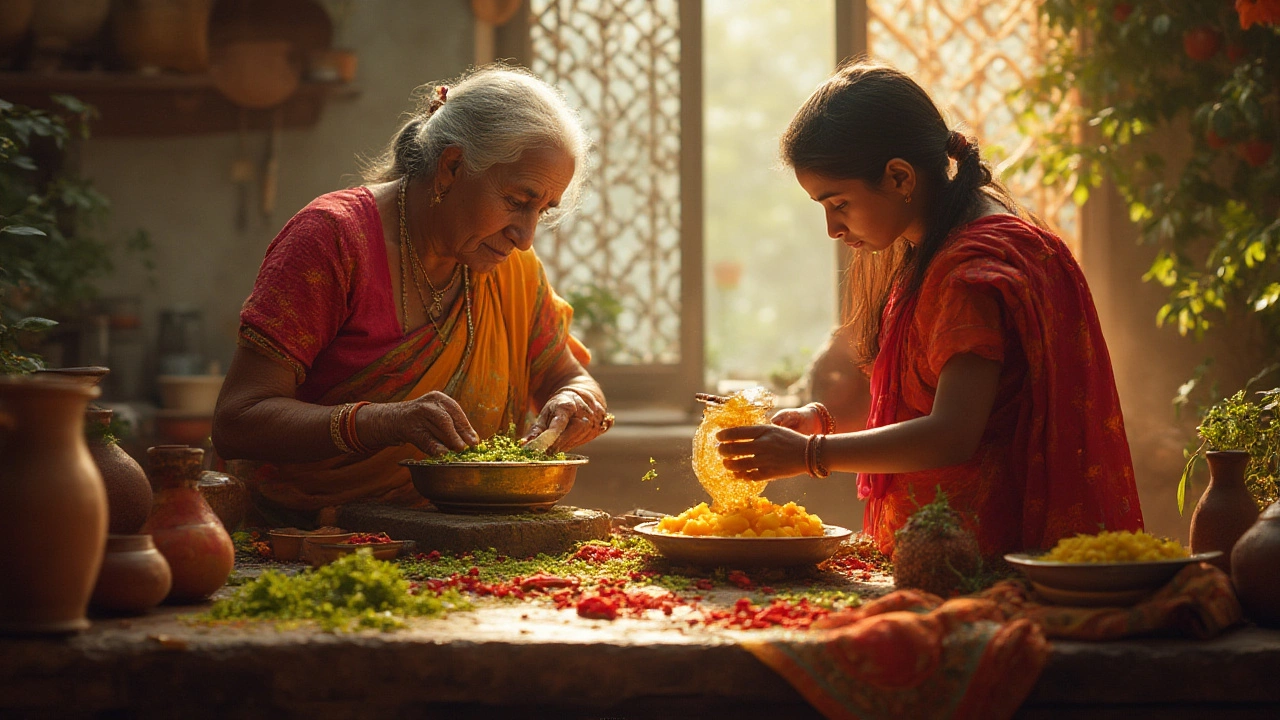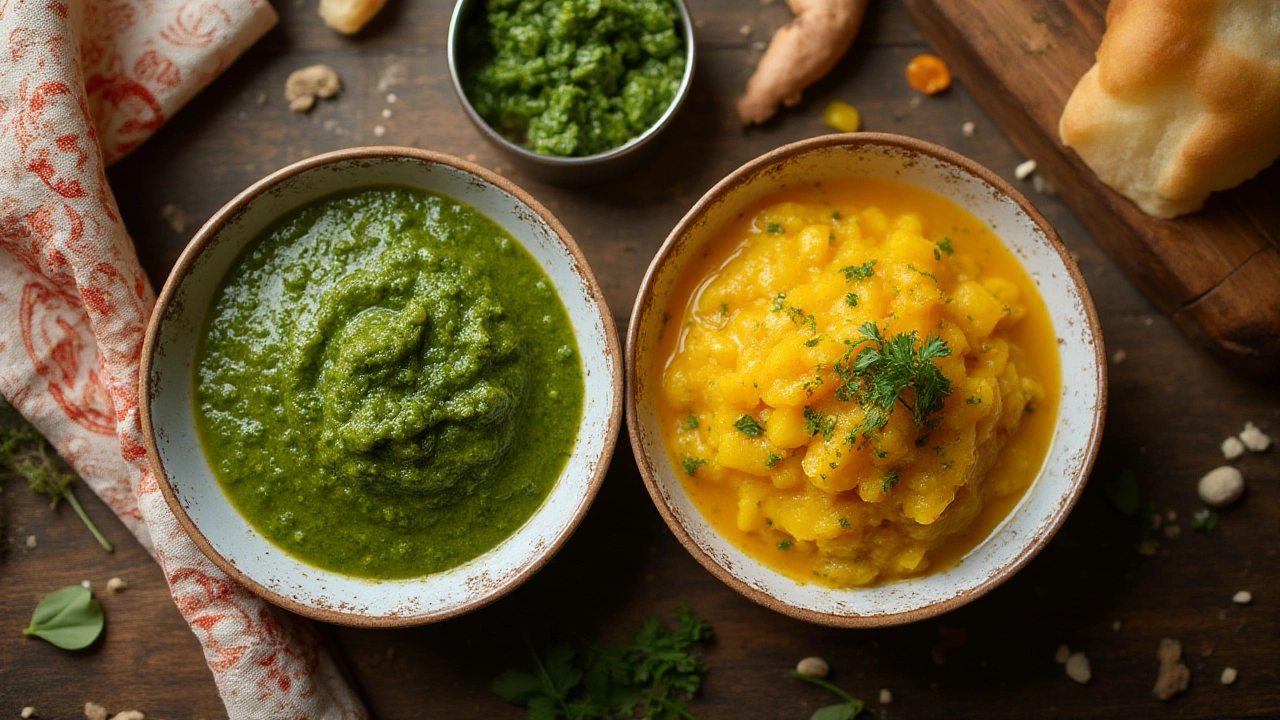Chutney vs Relish: Explaining the True Difference and Uses in Indian and Global Cuisines
 Jul, 30 2025
Jul, 30 2025
Ever stood in your kitchen, holding a jar of green coriander chutney in one hand and a tangy mango relish in the other, wondering what really sets them apart? It’s funny how these condiments, so common in Indian and Western cuisine, live in the same world, but play by totally different rules. You’ve probably heard both terms tossed around at family get-togethers or read them on fancy restaurant menus, but most folks honestly couldn’t tell you what makes a chutney a chutney and a relish a relish. If you’re hoping for a simple answer, you might be surprised — the truth includes centuries of tradition, a bit of science, and more than a few personal tricks passed down from grandmothers. Let’s cut through the confusion and flavor up your kitchen know-how with real facts and tasty tips.
Origins and History: A Tale of Two Condiments
Chutneys have ancient roots in India. The word "chutney" comes from the Hindi word "chatni," which means "to lick" or "to eat with relish". Archaeologists digging around the Indus Valley Civilisation (that’s more than 4500 years ago) have found evidence of spice mixes pounded with fruit, which sounds suspiciously like an early chutney. Throughout India’s long and tasty history, chutneys appeared in royal feasts and everyday meals, always evolving to match what ingredients were available — from tamarind and coriander in the south to mint and raw mango in the north. Chutneys came to the UK thanks to the British Raj, who tweaked recipes to suit their sweet tooth and made them shelf-friendly by loading them with vinegar and sugar. That’s how you get that dark, tangy Major Grey’s-style chutney you’ll spot in British pantries.
Relish, on the flip side, takes you to 18th-century Europe and America. While pickling veggies and fruits is ancient, a “relish” is a mid-1700s American term for pickled or cooked chopped vegetable mix, flavored with vinegar, sugar, and various spices. Cucumber relish is still king in American diners (think of what gets dolloped onto sloppy burgers or hot dogs), but the word stretches as far as piccalilli (a British tangy yellow mustard relish) and chow-chow (a Southern American favourite of pickled mixed veggies). The magic with relishes is their preserved crunch and piquant flavor, a trick that let people enjoy summer’s bounty through winter.
Here’s something wild: While a chutney could technically be a relish and vice-versa, the cultures, purposes, and recipes are so distinct that even the world’s best chef wouldn’t call them interchangeable. British “chutneys” today are really sweet-and-tangy relishes inspired by Indian recipes!
Key Ingredients and Their Preparation Styles
Let’s talk ingredients. A proper Indian chutney bursts with fresh herbs (like coriander or mint), fruits (such as mango, coconut, or gooseberry), or tangy veggies (like tomato or tamarind). Throw in roasted spices, chilies, a squeeze of lime, and sometimes jaggery for a hint of sweetness. Chutneys come together fast — a rough grind or, in today’s times, a quick zizz in the mixer-grinder, and they’re ready to eat. No waiting required, and rarely any cooking or preservation. Think of green chutney with samosas, coconut chutney with dosas, or fiery garlic chutney with vada pav — these are made to eat the same day.
Relishes, in contrast, usually get chopped up much finer and cooked down gently with vinegar and sugar. They might include combinations like cucumber, bell pepper, onion, and mustard seeds (classic American relish), or cauliflower, gherkins, and turmeric (for piccalilli). Most relishes need a bit of patience — you let the mixture cook until everything turns tender yet still keeps a little bite. To get that sweet-sour kick, the vinegar is essential. And yes, relishes are made to last. Pack them into sterilised jars and they’ll sit out a whole year if you don’t gobble them up first.
Here’s a quick head-to-head for your next kitchen debate:
| Feature | Chutney | Relish |
|---|---|---|
| Origin | India | Europe/USA |
| Main Ingredients | Herbs, fruit, fresh veggies, sometimes spices | Pickled or cooked veggies/fruits, vinegar, sugar, spices |
| Texture | Coarse/paste, can be smooth or chunky | Finely chopped/cubed, always chunky |
| Cooking | Usually raw or briefly cooked | Almost always cooked down |
| Preservation | Short-term, fresh, rarely preserved | Made to jar and preserve for months |
| Flavour Profile | Spicy, tangy, sometimes sweet, very fresh | Sour, sweet-tangy, less spicy, preserved |
| Classic Pairings | Indian snacks, dosas, parathas | Burgers, hot dogs, sandwiches |
An easy tip when making chutney: always use fresh ingredients and blitz them just enough to get that balance between texture and spreadability—too smooth can get gloopy, too coarse won’t hold on your vada pav. For relish, cut everything even-sized so the flavors blend well, and gently simmer to avoid turning it into mush. Sterilise your jars before filling to keep that relish tasting bright and safe for months.

How They’re Served: Culinary Roles and Pairings
This is where the fun begins. Chutneys love attention—they’re the zesty, spicy influencers of the Indian meal. You’ve seen chutney on your thali, for sure, sitting right next to that mini bowl of dal, ready for you to scoop with roti or rice. It’s not just about taste but about texture too—think of soft idlis dipped into a creamy coconut chutney, or crispy pakoras getting tangy green chutney on top. Chutneys act as flavor boosters, breaking up the monotony of a meal. Some are meant for dipping, others for spreading or even folding into rice for instant flavor. Mango chutney with papad is a legendary combo, but so is spicy tomato chutney on a buttered toastie. And don’t miss the sharp, garlicky lehsun chutney sprinkled on a Mumbai vada pav.
Relishes, by design, want to sit quietly on the side and enhance without stealing the show. America’s favorite is cucumber relish, often spotted on hot dogs or doused on burgers for a little sweet crunch. British pub-goers have Branston pickle relish with cheddar cheese sandwiches, while Southern US kitchens keep jars of okra or green tomato relish for fried chicken nights. In piccalilli, the bright yellow tang livens up plain ham sandwiches or mild cheeses. Relishes are about balance—adding sour and sweet, cutting through greasy or heavy foods, and giving you a bite of texture just when you need it.
Indian households often make distinctions — only a proper fresh chutney will make it to a South Indian breakfast plate, while jarred, preserved chutneys are more of a northern, sometimes colonial-era throwback. Westerners, meanwhile, tend to use store-bought relishes because they love the year-round convenience. Here’s a trick: if you’re ever out of green chutney during mango season, a bit of mango relish, blended with coriander leaves, can make a wild fusion dip for chips or cutlets. Don’t be afraid to experiment — the only rule is to enjoy the contrast in flavors and textures.
If you love pairing tips, these work every time:
- Chutney with deep-fried foods: Coconut or mint chutney makes pakodas and samosas pop in your mouth.
- Thick tamarind chutney on chaat: The sweet-tang cuts through spicy ragda or pav bhaji.
- Relish with basic grilled cheese: Add cucumber relish between bread for a surprising, addictive crunch.
- Piccalilli on roast meats: Its strong mustard hit will perk up bland meats or cold cuts.
Tips, Tricks, and Creative Twists for Home Cooks
Here’s the best part: making these at home is way easier than most people think, and the possibilities are endless. Let’s start with chutneys. The fresher the herbs, the more punch you’ll get. If you’re blending coriander or mint leaves, try adding a handful of peanuts or coconut — it makes the chutney creamy without muting the sharp notes. Got leftover mango? Chuck it into the mixer with green chilies and a pinch of salt for a sweet-hot summer treat. Unlike store stuff, fresh chutneys don’t last forever—use them in a couple of days and always refrigerate. Squeeze a bit of lemon juice to keep the color bright.
Relishes might sound dated, but they’re having a cool comeback in chef circles, even in Mumbai’s hipster cafes. Want your burger to taste like it came from a fancy diner? Shred a cup of carrots, chop some onions and cucumbers, add vinegar, sugar, salt, and a pinch of mustard powder, simmer for 15 minutes, and cool — instant homemade relish. If you’ve got a glut of summer veggies, whip up a batch and gift a jar to friends. Sterilising jars might seem fussy, but it makes your relish last months. Just pop washed jars in the oven for 10 minutes or dip in boiling water, let them dry completely before filling with the hot relish.
Allergic to something? No problem. Chutneys adapt. Skip garlic if you’re Jain, use roasted chana dal to thicken instead of peanuts, or try dried coconut if you’re low on fresh. For those craving extra tang in their relish, throw in green apples or even dried cranberries — the burst of tartness will wake up tired sandwiches. Always taste as you go; the magic is in balance.
For a fun experiment, try making a batch of both chutney and relish on the weekend. Serve mint-coriander chutney with samosas, and American-style relish with your aloo tikki burger. Invite friends, watch which gets finished first, and you’ll know why both hold a special place in kitchens everywhere — Indian or global.